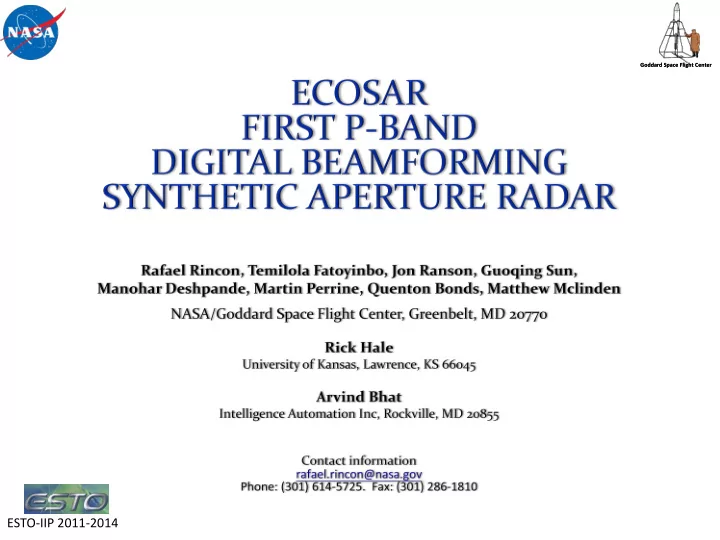

Goddard Space Flight Center Goddard Space Flight Center ESTO-IIP 2011-2014
Introduction Goddard Space Flight Center • EcoSAR is a new radar development at NASA/Goddard Space Flight Center for the measurements of terrestrial ecosystem structure and biomass. • The EcoSAR measurements will directly support science requirements for the study of the carbon cycle and its relationship to climate change. • EcoSAR will use Electronic Beam Steering and Digital Beamforming to implement Polarimetric and Interferometric Synthetic Aperture Radar (SAR) . 2 ESTO-IIP 2011-2014
Science Driver Goddard Space Flight Center The CARBON CYCLE. Carbon in the atmosphere is a controlling factor on climate and hence on ecological productivity and the sustainability of life. Science Question How are the Earth's carbon cycle and ecosystems changing, and what are the consequences for the Earth's carbon budget, ecosystem sustainability, and biodiversity? EcoSAR will acquire unique measurements that will help us quantify carbon in vegetation, and how it is changing. 3
Instrument Science Rationale Goddard Space Flight Center P-band SAR penetrates vegetation structure allowing the sensing of the entire canopy volume and woody density. Such measurements can be directly related to aboveground biomass. SAR measurements can be performed in most weather conditions and provide the capability of mapping the vegetation cover and changes due to natural and human- induced disturbances frequently. Polarimetric radar is sensitive to the shape, orientation and dielectric properties of scatterers and allows the identification and separation of the scattering mechanisms. 4
Pol-InSAR height measurements: - InSAR is highly sensitive to the spatial variability of Goddard Space Flight Center vertical structure parameters and enables accurate 3D localization of the scattering center. - EcoSAR will implement Pol-InSAR techniques to provide measurements that will allow us to separate ground from canopy and derive canopy height and to investigate the 3-D structure of volume scatterers . HV HH HV scattering phase center HH scattering phase center
EcoSAR Main Science objectives Goddard Space Flight Center • EcoSAR instrument will quantify: – Biomass – Canopy and Surface Height – Ecosystem structure and extent – Disturbance and recovery • Science Goals – Height with 1 m accuracy from single-Pass Polarimetric Interferometry – Biomass up to 200 Mg/ha from PolSAR measurements alone – Resolution of 0.75 m in range • Additional Science : – Solid Earth: deformation and subsidence – Cryo: ice sheet and permafrost depth – Hydro: surface water extent, salinity, soil moisture – Applications: soil/canopy penetration for archaeological studies
EcoSAR Architecture Goddard Space Flight Center • 18 transceivers support polarimetric and interferometric measurements. • Each antenna consists of 9 dual polarization, high bandwidth subarrays. Radar Transceivers, Antenna Subarrays, and Synthesizer/Acquisition and Processor (SAP) Unit • 18 Waveform generators directly synthesize P-band signals with up to 200 MHz bandwidth. • 18 Receivers will sample the radar returns directly. • Synthesizer/Acquisition and Processor system will be designed around the Xilinx Virtex 5 FPGA. Antennas • Digital I&Q demodulation, decimation and filtering will be performed on board. • Processor supports subsequent onboard radar processing (e.g., digital beamforming, SAR image formation, multi-look, etc…) SAP SBIR Prototype by IAI
EcoSAR System description Goddard Space Flight Center Center Frequency 435 MHz Pulse Length 1 usec – 50 usec Maximum Bandwidth 200 MHz Array Peak Power 40 Watts Polarization HH, VV, VH,HV PRF 100 Hz – 10 KHz Polarization Isolation < 25 dB Swath 4 km – 8 km Noise Equivalent σ o - 41 dB * Finest Range Resolution 0.75 m Total Number Channels 36 Single Look Azimuth 0.5 m Resolution Interferometric baseline 25 m Vertical Accuracy < 5 m EcoSAR will fly on the NASA P3 airplane based at Wallops Flight Facility
EcoSAR Concept Goddard Space Flight Center
EcoSAR Concept Goddard Space Flight Center
EcoSAR Concept Goddard Space Flight Center
Example of SAR and InSAR using DBSAR (L-band) measurements Goddard Space Flight Center Height (m)
Example of multiple beam technique Goddard Space Flight Center Flight Path Antenna θ 1 θ 2 r y r x a t h 1 S w r y r x a t h 2 S w F L I G H T T R A C K
EcoSAR Resolution Goddard Space Flight Center Azimuth (Cross Range) Resolution 0.5 m (single look) Range Resolution Slant Ground Low Resolution 44 m 25 m Medium Resolution 8.7 m 5 m High Resolution 1.3 m 0.75 m
EcoSAR Antennas Goddard Space Flight Center Antenna Parameters Type Micro-Strip Patch Center Frequency 435 MHz Bandwidth 200 MHz Gain 19 dB Area 3 m 2 Polarization Dual, linear Each antenna array mounts the P3 aircraft wing Cross Polarization Isolation < 25 dB Number of Sub Arrays 9 Total Number of Elements 27 3 m Three-element subarray 1.0 m The EcoSAR antenna arrays will allow to steer the beam across track Subarray S11 and S22 parameters Cross coupling is below -80dB
Schedule and Milestone Goddard Space Flight Center Year 1 Definition of the EcoSAR science and system requirements Antenna Arrays Design and fabrication Radar Electronics Unit Design and fabrication Year 2 Completion of Waveform generator/data system Testing and programming of waveform generator/data system Radar Electronics evaluation, testing and initial assembly. Full system integration and testing in laboratory and in anechoic chamber. Year 3 Installation and test flight operation of the system on the NASA P-3 aircraft Validation of EcoSAR test flight data sets Field Campaign 1 New Hampshire and Maine Field Campaign 2 Costa Rica Science Retrievals from EcoSAR campaigns
Concluding Remarks Goddard Space Flight Center • Our team has successfully completed the design of prototype dual polarized wideband P-band antenna element. A full array simulation is underway. • The aerodynamic analysis on antenna structure has been performed. • The radar transceiver schematic has been completed. Components specifications and availability are currently being investigated. • The processor development is scheduled to begin in August 2011.
Goddard Space Flight Center End of Presentation
Recommend
More recommend